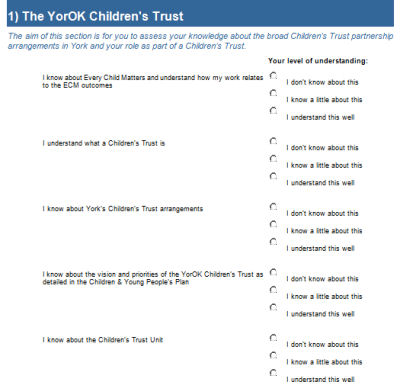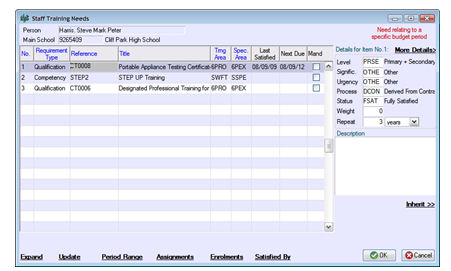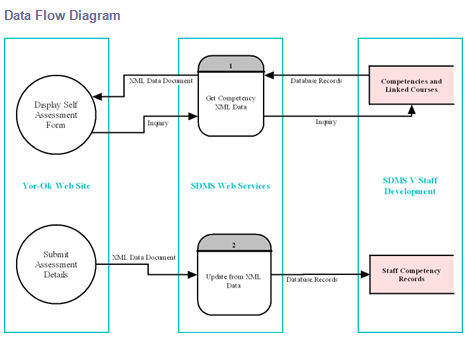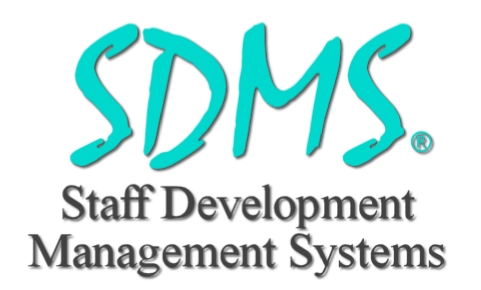City of York Council: Case Study
“At City of York Council, we feel that the on-going assessment and improvement in the skills of our staff is of the utmost importance to ensure the quality of the services we provide. We have been using SDMS Software for over 5 years now to manage information on our staff, regarding the training they take to gain the skills needed for their role. Recording these details in the well-structured database system allows us to easily get access to the information we need, when we need it. We have more recently implemented SDMS V e-Training for Web and Intranet access which allows self-serve access for our staff to record their own information which reduces a lot of administration in collecting data.
A new requirement for us is to get information on the skills of new staff during their induction for which we designed an on-line self assessment form which new employees can navigate to and answer questions on what they can and cannot do. This is aimed at addressing their needs through training in the areas they most need it. This was a separate web system from the SDMS software which would have meant that some administration would be required in copying the information over. SDMS have been working on this new project to allow the self assessment form to be flexibly defined from the competency records in the system including links to the courses managed in SDMS that will result in gaining the competency and for the assessment forms filled on-line to be used in an automated process to update the records of competencies held and required by staff. This will help us to identify employees’ training needs and book training appropriately.”
City of York Council
The City of York Council Children’s Trusts, known as YorOK, are local partnerships that bring together all partners and organisations responsible for providing services for children, young people and families, together focusing on a shared commitment to improving children’s lives. The aim of a Children’s Trust is to ensure that all children have the support they need to ensure they are healthy, stay safe, enjoy life, achieve well at School and beyond, make a positive contribution to society and achieve economic well being.
City of York Council has been using SDMS software since 2005 to help with the training development opportunities working with and for children that are managed, commissioned and facilitated through the Training and Development Unit. The unit acts as a hub for all professional development information for those working for the Children's Workforce.
With the help of SDMS, the Training and Development Unit ensure the delivery of high quality professional development at all levels. They have also implemented an On Line Course Booking System using SDMS e-Training for the Web which allows the administration team to record new training courses and for this information to appear immediately on the on-line site (accessible via http://www.yor-ok.org.uk/tdu). This has allowed City of York Council to give On Line Access to both Council Staff and Staff from across the Children’s Workforce to see what courses are available and then apply for places on those courses.
The City of York Council has been looking at ways to move toward a Paperless environment, a goal often aspired to but rarely achieved in most organisations. Apart from saving the environment, running a Paperless office would reduce administrative costs throughout the organisation and in many cases improve the efficiency and effectiveness of processes. The use of SDMS V Staff Development and SDMS V e-Training have helped in this goal by allowing the administration of training management to be done more effectively and for the ownership of booking staff onto courses to be given to the individuals and their Line Managers by allowing course applications to be made on-line. The web-based system also allows for other types of information to be entered and modified such as Course Evaluation, CPD/Self Study, Personal Details, Appraisal and others. Each piece of information that can be managed via Web Systems is another paper form, or several, that will no longer be required.
The main issue with running a paperless environment is that there are so many tasks and processes within an organisation that require movement of information and many of the processes in place will use paper forms for this. The best solution is in web-based systems which can be available to all staff to allow an equivalent form based method to be used but without paper.
History of the SDMS Web Services Project
The project started with a support call from City of York Council asking how their on-line Induction Self Assessment could be linked with the competencies in SDMS so there was a single point of entry for competency information and so that when an employee fills in the assessment form on-line, the information could come through as competencies required and held for the person.
A series of project meetings were held between SDMS and City of York Council over several months to discuss how the requirement could be achieved. Firstly, the precise user requirements were identified so that the project could be designed to ensure these were met. We discussed changes that would be needed to the structure of the SDMS competency file to allow for certain details specific to the assessment form could be held. There were also changes identified to the way that person information was collected from the assessment form so that enough data would be available to link the person filling in the form to their staff record in SDMS.
To deliver this project, SDMS have put extensive development time in to open up a new technological approach to accessing the SDMS system data. This work has resulted in the development a framework which the XML Web Services will depend upon for the key functions in reading and updating data.
The requirement for competency data to be available as XML documents was identified in the meetings so a part of this framework is the ability to produce XML data from the SDMS system and to update the data from XML documents. For the specific requirement of this project, the XML data includes details on competencies and the courses that could be taken to achieve them.
Realising the benefit of the self-assessment approach and the potential for this to be used in areas other than induction, or in several different forms, we have designed the project to identify which competencies should be included in the form based on the competency type field. This means that further forms could be set up using a different competency type for each.
The project is currently in the beta phase and being tested by SDMS and City of York Council to ensure that it will meet the needs of the Council and to identify areas of improvement or additional requirements before starting to use the Web Services in a live environment.
The YorOK Website Project
One of the new systems that City of York Council are putting in place is an Induction Self Assessment form to be completed via the web. This is essentially a list of competencies that would be required to work in certain positions within the Children and young People’s Workforce. Staff members would be asked to complete the questionnaire style form on-line.
The following is an extracted section from the YorOK Self Assessment form:
Assess your current level of understanding of YorOK

The self assessment form shows a list of competencies that would typically be required for certain roles in the Children’s Workforce and asks staff to say whether they fully understand, partially understand or know nothing of the competency.
Upon completion of the Self Assessment, the person will be shown a list of courses being run for the workforce that would result in or contribute to them gaining the competencies they do not currently have. The individual, possibly with their Line Manager, could then apply to book on to those courses as appropriate.
SDMS Competency XML Web Services
As competencies are dealt with in SDMS V Staff Development, SDMS has been working with City of York Council to deliver an XML Web Services based interface that allows data on Competencies to be read directly from the SDMS data to be used in this Induction Self Assessment form. This also includes a list of courses against each competency so that the site can determine which courses to show after the assessment. An HTML link is also provided to view full details of the courses in the SDMS V e-Training system where the person can apply to book onto the course on-line.
Working in the other direction, the responses entered on the form can then be sent to the SDMS data through the web services so that the competencies will be allocated to the staff member who filled in the form. If a person has a competency then this will be recorded in SDMS. If they do not, a record will be saved showing that the person needs the competency.
Changes to SDMS V Staff Development
The competencies screen has been changed in the windows application to include details buttons to allow further descriptions to be added for the competency, the competency group and the competency type. These details are used for the various sections of the induction self assessment page.

Optional Add-On Modules
An additional option for SDMS V Staff Development and SDMS V e-Training is the SDMS Needs Module which allows training needs to be identified for individuals and for course enrolments to be planned based on the needs that may have been identified during Appraisal or Performance Review.

The Competency Web Service can also link with the Needs module so that when a competency has been identified as something the person does not have, an appropriate training need can be automatically raised in the system.

Issues
A potential problem that has been identified with using this approach is that unless the person filling the form is a registered web user in the SDMS System, it would be very difficult to identify which person record in SDMS the data should be recorded against. The method we recommend for resolving this is to force the user to firstly log in using their SDMS e-Training login details which will ensure they are linked with their own record.
City of York Council felt that making people register as an e-Training user before filling in the self-assessment might put people off filling it in at all as it turns one task in to two. This means that measures need to be used to allow the process of registering to be done later.
To achieve this, the person will need to supply specific details that would identify them to the administrative staff. This could be an email address but in some cases, an email address may be shared between people or someone might not have one. Whichever way this is done, and whatever information is provided, this will always rely on administrative staff identifying the person and linking them to their staff record.
To avoid the person having to enter the information twice, the details would need to be stored temporarily so that once the person’s staff record is linked to them; the system can move the data in to the system. With the competency data, this would mean that a copy of the staff competencies file would be used to store the temporary information using an identifying field to link to the person’s registration details. Then once the registration is confirmed by the administrators, the information would be moved to the real file.
Those who are familiar with SDMS V e-Training will know that there is a registration form on the website that allows staff to enter their details and administrators to link their login details with their SDMS staff record. The web services can link with the e-Training Login details to authenticate users in the same way allowing data being brought out via the web services to be related to the person viewing it. This is the recommended method of identifying the person as there would then be a single login and password that the person could use between e-Training and any other systems using this technology.
Working Practices
As with all changes to procedure, the working practices of both administrative staff in charge of the process and other staff who will be using the new systems will change to suit the requirements.
For this case, all of the competencies that will be assessed on the form will need to be entered into SDMS V Staff Development by the administrative staff using specific field values to identify that the competencies should appear the assessment form.
Staff will need to adopt the process of logging on to the system to fill in the form and book themselves on training. They will need to be told how to use the system and why it is of benefit to them.
You can not always make people work in the way that is required but by making it a simple process and part of standard procedure within the organisation, the approach can be accepted into the working methods and ultimately benefit the organisation and everyone working there.
Future Use
This project has involved some innovative new coding design aimed at allowing us to deliver solutions such as this in a simpler, quicker and more cost-effective manner. The web services interface offers XML interoperability using XML Schemas and data documents to integrate data between the SDMS system and other systems or SQL databases. This is the top level of this project which relies on the bulk part of this development which is a new application extension to access and modify data in a Btrieve database. Btrieve is the database platform that has been used by SDMS Systems for over 15 years. It is an alternative to SQL that has offered us greater flexibility in the design of our systems but until now has only been accessible through our applications made using Magic; the primary development language used in SDMS and through Crystal Reports.
This work has opened up the database to be useable in a wide potential range of services developed using Microsoft VB.NET and ASP.NET which could mean anything from websites, to system integration modules. With the new technology now in place, we can offer bespoke services to create new services for your specific requirements allowing you to deliver information to individuals and potentially improve communication and data flow throughout the organisation.
Please call us for more information on the SDMS Sales Line: 01952 200911.









